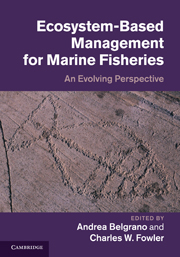Book contents
- Frontmatter
- Contents
- List of contributors
- Foreword
- Acknowledgments for cover artwork
- Introduction
- PART I CURRENT FORMS OF MANAGEMENT
- PART II ELEMENTS OF IMPORTANCE TO MANAGEMENT
- 5 Unintended consequences sneak in the back door: making wise use of regulations in fisheries management
- 6 Population dynamic theory as an essential tool for models in fisheries
- 7 Recovery of former fish productivity: philopatric behaviors put depleted stocks in an unforeseen deadlock
- 8 Boundary shifts: from management to engagement in complexities of ecosystems and social contexts
- 9 Civil society and ecosystem-based fisheries management: traditional roles and future opportunities
- PART III USING PATTERNS
- Afterword
- Index
- Plate section
6 - Population dynamic theory as an essential tool for models in fisheries
from PART II - ELEMENTS OF IMPORTANCE TO MANAGEMENT
Published online by Cambridge University Press: 17 February 2011
- Frontmatter
- Contents
- List of contributors
- Foreword
- Acknowledgments for cover artwork
- Introduction
- PART I CURRENT FORMS OF MANAGEMENT
- PART II ELEMENTS OF IMPORTANCE TO MANAGEMENT
- 5 Unintended consequences sneak in the back door: making wise use of regulations in fisheries management
- 6 Population dynamic theory as an essential tool for models in fisheries
- 7 Recovery of former fish productivity: philopatric behaviors put depleted stocks in an unforeseen deadlock
- 8 Boundary shifts: from management to engagement in complexities of ecosystems and social contexts
- 9 Civil society and ecosystem-based fisheries management: traditional roles and future opportunities
- PART III USING PATTERNS
- Afterword
- Index
- Plate section
Summary
Abstract
The state of world fisheries, and their impact on ecosystems, is certainly cause for trying to manage them differently. However, a focus on ecosystems to the exclusion of factors involved in basic population dynamics is extremely problematic. Any form of more holistic management cannot ignore fundamental insights gained from the study of single populations, predator–prey interactions, and the complexity of such systems. Theory helps understand the dynamics of populations and their interactions in the context of environmental circumstances. Such understanding emphasizes the essential importance of ensuring that such insight is taken into account in fisheries management. There are fundamental principles involved in the population dynamics of any species found in ecosystems, and the study of these dynamics continues to add to our appreciation of such principles. The concepts involved are basic components in our understanding of the larger system and cannot be ignored. They include the role and importance of competition, population regulation, predation, resource availability, cooperation, environmental variation, fishery impacts, and emergent patterns (stabilizing tendencies). This chapter explores a number of such factors and their fundamental nature in the dynamics inherent to population interactions and, ultimately, ecosystems. There is special attention to the role of fishing and its influence on population dynamics. This is not confined to simple single-species considerations, however, as the population dynamics of a single resource species is directly linked to that of its prey, competitors, and environmental variation.
- Type
- Chapter
- Information
- Ecosystem Based Management for Marine FisheriesAn Evolving Perspective, pp. 218 - 231Publisher: Cambridge University PressPrint publication year: 2011

